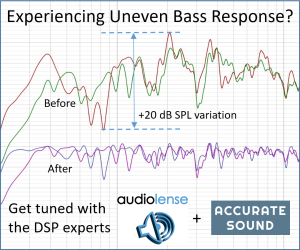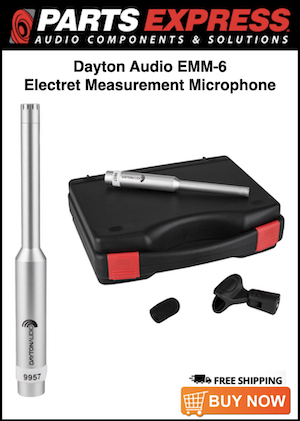Tony V.
Senior Member
More
- Preamp, Processor or Receiver
- Onkyo TX RZ920
- Main Amp
- Samson Servo 600
- Additional Amp
- QSC MX1500
- Universal / Blu-ray / CD Player
- Panasonic 220
- Streaming Subscriptions
- Denon DT 625 CD/Tape unit, Nintendo WiiU, and more
- Front Speakers
- EV Sentry 500
- Center Channel Speaker
- EV Sentry 500
- Surround Speakers
- Mission 762
- Surround Back Speakers
- Mission 762
- Subwoofers
- SVS PB13u
- Video Display Device
- Panasonic AE 8000
- Remote Control
- Logitech 1100
Last year I tried playing with turning audyssey off and then manually adjusting the EQ on my two Yamaha YDP2006 EQs that I have on my front 3 channels and sub.
With all the automated room EQ flavors available now (Audyssey, MMAC, YAPO, Dirac) one begins to think how much is too much. Ive been wondering if in my case I could accomplish the same or even better results myself using outboard EQ on the front sound-stage. Onkyo got me thinking as they are no longer applying EQ to the front channels with their proprietary room eq that is in their receivers now.
One of the things Ive learnt long ago is that applying EQ filters on frequencies above 400Hz that are not identical on both channels will cause your imaging to collapse across the front.
To prove this I set up a preset with no filters applied. I played some well recorded music that I use for demos and that I know. I played the track and then took a filter with average Q and added it only to the left channel at 4K (so it was a nice boost from about 2K up to 6K) and then another at 2K on the right channel and I was actually astonished how much just that caused the image to move into the center of the room or what seemed to pull it from where it should be.
I then restored the flat setting and tried several different frequencies again different on the two channels cutting and or boosting and each time the difference was noticeable (last night I asked my wife to sit in the room while I did this and even she commented at the difference and how it pulled the sound into the center of the room).
I then did the same test but this time I locked the left and right channels so any adjustment would be done evenly on each channel, this did not effect the image at all other than boosting/cutting the frequency range of that part of the music.
I know that with auto room correction it is quite common to have filters automatically added that are different on each channel as not many rooms are perfectly symmetrical and speaker placement is never ideal so using auto room EQ would be concerning to me as that is not the right method and should be avoided. I wonder what others thoughts are on this is and if I am correct thinking Onkyo may be on the right path by eliminating EQing the mains and only focusing on the sub and surrounds and also that room acoustics should be addressed and take a high priority over EQ.
NOTE: I should also clarify that EQ on the subwoofer channel is a very good thing and should always be done.
With all the automated room EQ flavors available now (Audyssey, MMAC, YAPO, Dirac) one begins to think how much is too much. Ive been wondering if in my case I could accomplish the same or even better results myself using outboard EQ on the front sound-stage. Onkyo got me thinking as they are no longer applying EQ to the front channels with their proprietary room eq that is in their receivers now.
One of the things Ive learnt long ago is that applying EQ filters on frequencies above 400Hz that are not identical on both channels will cause your imaging to collapse across the front.
To prove this I set up a preset with no filters applied. I played some well recorded music that I use for demos and that I know. I played the track and then took a filter with average Q and added it only to the left channel at 4K (so it was a nice boost from about 2K up to 6K) and then another at 2K on the right channel and I was actually astonished how much just that caused the image to move into the center of the room or what seemed to pull it from where it should be.
I then restored the flat setting and tried several different frequencies again different on the two channels cutting and or boosting and each time the difference was noticeable (last night I asked my wife to sit in the room while I did this and even she commented at the difference and how it pulled the sound into the center of the room).
I then did the same test but this time I locked the left and right channels so any adjustment would be done evenly on each channel, this did not effect the image at all other than boosting/cutting the frequency range of that part of the music.
I know that with auto room correction it is quite common to have filters automatically added that are different on each channel as not many rooms are perfectly symmetrical and speaker placement is never ideal so using auto room EQ would be concerning to me as that is not the right method and should be avoided. I wonder what others thoughts are on this is and if I am correct thinking Onkyo may be on the right path by eliminating EQing the mains and only focusing on the sub and surrounds and also that room acoustics should be addressed and take a high priority over EQ.
NOTE: I should also clarify that EQ on the subwoofer channel is a very good thing and should always be done.
Last edited:







 And ... AND... we now have manufacturers making AMPS that can help eliminate room modes. Brilliant perhaps.
And ... AND... we now have manufacturers making AMPS that can help eliminate room modes. Brilliant perhaps.




